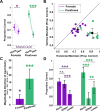This is a preprint.
Asymmetries in foveal vision
- PMID: 39763996
- PMCID: PMC11702834
- DOI: 10.1101/2024.12.20.629715
Asymmetries in foveal vision
Update in
-
Asymmetries in Foveal Vision.J Neurosci. 2025 Sep 3;45(36):e0055252025. doi: 10.1523/JNEUROSCI.0055-25.2025. J Neurosci. 2025. PMID: 40695598 Free PMC article.
Abstract
Visual perception is characterized by known asymmetries in the visual field; human's visual sensitivity is higher along the horizontal than the vertical meridian, and along the lower than the upper vertical meridian. These asymmetries decrease with decreasing eccentricity from the periphery to the center of gaze, suggesting that they may be absent in the 1-deg foveola, the retinal region used to explore scenes at high-resolution. Using high-precision eyetracking and gaze-contingent display, allowing for accurate control over the stimulated foveolar location despite the continuous eye motion at fixation, we investigated fine visual discrimination at different isoeccentric locations across the foveola and parafovea. Although the tested foveolar locations were only 0.3 deg away from the center of gaze, we show that, similar to more eccentric locations, humans are more sensitive to stimuli presented along the horizontal than the vertical meridian. Whereas the magnitude of this asymmetry is reduced in the foveola, the magnitude of the vertical meridian asymmetry is comparable but, interestingly, reversed: objects presented slightly above the center of gaze are more easily discerned than when presented at the same eccentricity below the center of gaze. Therefore, far from being uniform, as often assumed, foveolar vision is characterized by perceptual asymmetries. Further, these asymmetries differ not only in magnitude but also in direction compared to those present just ~4deg away from the center of gaze, resulting in overall different foveal and extrafoveal perceptual fields.
Figures




References
-
- Randall Harry G, Brown Darlene J, and Sloan Louise L. Peripheral visual acuity. Archives of Ophthalmology, 75(4):500–504, 1966. - PubMed
-
- Westheimer Gerald. Scaling of visual acuity measurements. Archives of Ophthalmology, 97(2):327–330, 1979. - PubMed
-
- Millodot Michel, Johnson Chris A, Lamont Anne, and Leibowitz Herschel W. Effect of dioptrics on peripheral visual acuity. Vision Research, 15(12):1357–1362, 1975. - PubMed
-
- Rijsdijk JP, Kroon JN, and Van der Wildt GJ. Contrast sensitivity as a function of position on the retina. Vision research, 20(3):235–241, 1980. - PubMed
-
- Wright MJ and Johnston A. Spatiotemporal contrast sensitivity and visual field locus. Vision Research, 23 (10):983–989, 1983. - PubMed
Publication types
Grants and funding
LinkOut - more resources
Full Text Sources
